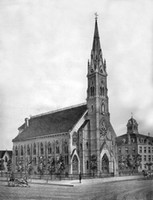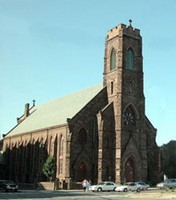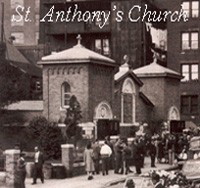St. Patrick – St. Anthony Church
Introduction
Text-to-speech Audio
Images
St. Patrick's Before the Fire

St. Patrick's in its Current Appearance

The Original St. Anthony's Church, Used Before the Flood of the Connecticut River

Backstory and Context
Text-to-speech Audio
St. Patrick – St. Anthony Church, once known just by the name St. Patrick’s, was the work of New York Architect Patrick C. Keeley, who was recognized not only for his stylistic accomplishments but for his widespread respect as an Irish Architect in a time when anti-Irish sentiment abounded. Keeley designed the church with inspiration from the Gothic Revival Style in 1876, utilizing Irish Catholic motifs that remain visible on the structure into the present day.
Rough brownstones and a showy gable roof are overlooked by a tall steeple. The building is dotted with the characteristic arches and curves of the Gothic Revival Style, and, as a result, it stands out from all other buildings in the district, with particular contrast to the other religious and community buildings nearby. While the Masonic Temple in the district is in a Gothic Revival style, its influences are drastically different, resulting in a very different appearance.
St. Patrick’s was not Keeley’s only work in this style in the City of Hartford. Another time-tested church, the Asylum Hill Congregational Church, is also recognized as a historically-impactful building, displaying the skillful design work Patrick Keeley came to be known for.
The congregation at St. Patrick – St. Anthony can trace its history as far back as 1829 to Connecticut’s first Catholic church and parish, Holy Trinity. Holy Trinity’s first home was in a chapel that once belonged to the Episcopal Christ Church, located on Talcott and Main in Hartford. It was at this location that Holy Trinity established Hartford’s first Catholic school and Sunday school in 1830. Throughout the rest of the early 1800s, the Holy Trinity Parish would go on to found Connecticut’s first Catholic cemetery one of the earliest, if not the earliest, Catholic newspapers in the state.
The Holy Trinity parish continued to grow throughout the 1800s, eventually increasing by over ten times its original size. While the former Christ Church building had served a small parish well, it was no longer suitable for a congregation of over 1000 members. With the hope of serving a congregation that was likely to continue to grow, Holy Trinity commissioned the design of a church which would be named St. Patrick’s to honor the majority Irish congregation that called the Holy Trinity parish home.
In 1853 and 1875, two fires would come upon the Holy Trinity parish. The first would engulf the old church building and the second would destroy the still-young St. Patrick’s church. With incredible support from the parishioners and new Catholics coming to Hartford, St. Patrick’s was rebuilt from the ground up within the remaining walls of the old St. Patrick’s. The resulting church is the very same building that is now known as St. Patrick – St. Anthony.
The history of St. Anthony’s parish and church began in 1895 with an influx of Catholic immigrants from Italy. Recognizing the need for a parish to serve this community, the Hartford Diocese organized the purchase of another church that once belonged to an Episcopal congregation. The St. Anthony’s congregation quickly outgrew this small church and built a second church on Talcott Street in 1921.
St. Anthony’s new church lasted just under 15 years before it was severely damaged by the 1936 flooding on the Connecticut River. While the congregation still gathered in the building, it was clear that a new solution to house the parishioners would be necessary. The 40s and 50s brought many changes to the Catholic communities of Hartford. The formation of a Catholic library and St. Anthony’s School were only part of these changes.
As the Catholic population of Hartford moved away from central Hartford, urban redevelopment led to the demolishing of the damaged buildings that St. Anthony’s had been using for years. This led Archbishop Henry O’Brien of the Hartford Diocese to spearhead the merger of St. Patrick’s and St. Anthony’s congregations, renaming the proud church St. Patrick – St. Anthony.
The new, combined parish of St. Patrick – St. Anthony has served Hartford faithfully ever since, being a locus for Catholic charity and community in the heart of a city that has steadily grown throughout the last century. St. Patrick – St. Anthony underwent a major transformation in 1990 when the Archbishop of the Hartford Diocese, Archbishop John Wealon, sought the aid of the Franciscan Friars to bring their ministry to the church.
Since the Franciscans took leadership of St. Patrick – St. Anthony, the parish has focused on helping marginalized groups in Hartford. As a part of this mission, the church has partnered with food pantries, unemployment aid groups, HIV/AIDS charities, and more.
As of the creation of this entry, St. Patrick – St. Anthony stands not only as an architectural landmark but also as a symbol of the rich, diverse history of the Catholic community of Hartford. Its location in the center of the city makes it the perfect destination for visitors to Hartford with an interest in Catholic history or the development of the communities of Hartford.Cite This Entry
Sovis, Emilie and Clio Admin. "St. Patrick – St. Anthony Church." Clio: Your Guide to History. November 8, 2018. Accessed April 4, 2025. https://theclio.com/tour/551/9
Sources
Official NPS NRHP Documentation for the Ann Street District. National Park Service NRHP Archive. October 27, 1983. Accessed November 08, 2018. https://npgallery.nps.gov/GetAsset/9e1c0361-bfaa-4aa4-857d-7b03317028e4/. Official NRHP Documentation for the Church and the District

